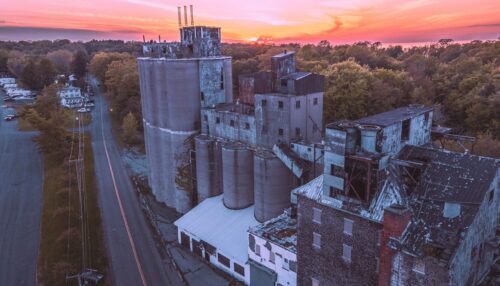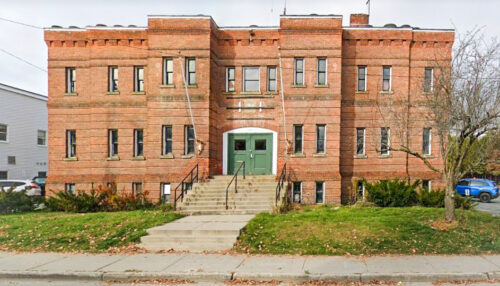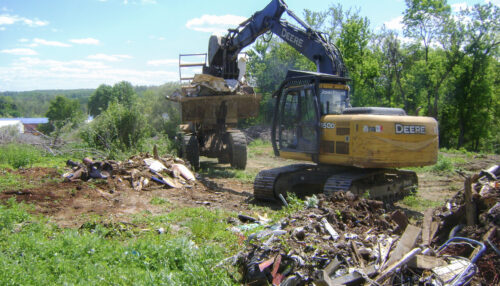
The Early Bird’s Guide to FY26 EPA Brownfield Grants
August 4, 2025
By: Derek Street
Anyone reading this likely shares a common goal: uncovering every possible clue about the FY26 brownfield grant competition, as well as identifying potential changes the new administration may introduce— especially those that signal how guidelines will be shaped to influence who wins.
With the passage of the Senate’s version of the Big Beautiful Bill (BBB), we now have more clarity. If you were applying, or planned to apply, for a grant from the United States Environmental Protection Agency (EPA) that was funded out of the Inflation Reduction Act (IRA) of 2022, the door is now closed. Many of the IRA programs specifically have had their unobligated funding rescinded.
For brownfields, and based on a non-legal analysis, the new law does not contain provisions that strip EPA of the unobligated Bipartisan Infrastructure Law (BIL) funding that has supported elevated grant levels. If they didn’t rescind the money, and it’s still illegal for the federal government to impound it, we can assume there will be elevated funding levels for brownfield grants and this fall is your last chance to turbocharge a brownfield program of your own, tackle a large remediation project, or replenish the funding that has done so much for your community.
That also means it’s time to make early preparations for what is always a competitive process, and potentially even more competitive than normal, as communities across the country prepare to take their best last shot. And how do you get a leg up on the competition? START EARLY!
Using history as our guide we can anticipate seeing
- Community-Wide Assessment Grants at $500,0000
- Coalition Assessment Grants around $1,200,000
- Community-Wide State and Tribal Assessment Grants for $2,000,000;
- Cleanup Grants at around $500,000, $2,000,000 and $4,000,000; and,
- Multipurpose Grants for $1,000,000.
With a new administration determined not to continue the legacies of the previous administration, we can be confident environmental justice (EJ) criteria and any references to climate change in the FY26 guidelines won’t reappear. Until USEPA releases something about the fall competition, we don’t know what the new focus in awarding brownfield grants under the current administration will look like, or what new criteria will be included. So how could you possibly start early?
Don’t Hesitate When Opportunity Knocks
This was always going to be the last brownfield funding cycle with elevated grant levels irrespective of the political party in power. If you are waiting for a “better time” to apply or get started, the window is quickly closing. The uncertainty of how and where within the guidelines the current administration will add its own focus is why early preparations matter.
If you recall the previous federal on Opportunity Zones and tax-incentivized investments, it’s worth noting the BBB contains a provision to renew and extend the Opportunity Zone program from January 1, 2027, to December 31, 2033. With that in mind, you can likely adapt to whatever forthcoming changes there are to the guidelines when they are released. By starting now, you’ll position your community or organization to adapt quickly whether FY26 is a return to an older set of brownfield selection criteria, focuses on economic aspects, or is a hybrid with new policy themes.
It is not realistic to think about all the criteria and the whole way the competition is run will change. That would take an act of Congress. Within the authorizing legislation of the brownfield grant program (CERCLA 104k for competitive grants) the following considerations are required:
“… shall take into consideration—
- the extent to which a grant will facilitate the creation of, preservation of, or addition to a park, a greenway, undeveloped property, recreational property, or other property used for nonprofit purposes;
- the extent to which a grant will meet the needs of a community that has an inability to draw on other sources of funding for environmental remediation and subsequent redevelopment of the area in which a brownfield site is located because of the small population or low income of the community;
- the extent to which a grant will facilitate the use or reuse of existing infrastructure;
- the benefit of promoting the long-term availability of funds from a revolving loan fund for brownfield remediation; and
- Such other similar factors as the Administrator considers appropriate to consider for the purposes of this subsection.”
What you’ll notice from the above text is a very similar tone to many of the criteria USEPA uses in the grant guidelines to evaluate applications, and the language will sound familiar if you are a seasoned applicant or grant writer. We know the criteria must include revitalization of properties for a purpose, meet the needs of a poor and/or small-population community where a brownfield site is located, and have a focus on reusing infrastructure. That is your pre-planning focus.
Before diving into those particulars, it’s important to start with the fundamental issue for many would-be applicants:
Easy Wins: Grants.gov and SAM.gov
If you’ve heard about brownfields grants and are deciding to apply for a new grant, or you are thinking of applying for the first time, it cannot be emphasized enough: you must have a working www.grants.gov and www.sam.gov account. Don’t wait until the RFA comes out to try and get them set up because it can be a slow, painful process—especially when everyone is in the same boat asking the helpdesk for support.
To apply you must have an www.sam.gov account that will be active through the end of the grant competition (likely in November 2025), a Unique Entity Identifier (UEI) generated by www.sam.gov, an active www.grants.gov account, and the final grant application will need to be submitted by your Authorized Organization Representative (AOR).
Common issues include the person who was the AOR having left the organization and a ticket needing to be submitted to the help desk to reassign the role, lost passwords, the account expiring before the application deadline, or other general IT issues. The Request for Applications (RFAs) do spell out procedures for submitting outside www.grants.gov, but from firsthand experience I can tell you it is not a good idea unless you have a paper trail a mile long of your attempts to rectify issues. For FY25, the Office of Brownfields and Land Revitalization (OBLR) rejected every application submitted outside www.grants.gov.
Clear Project Boundaries & Objectives
In the authorizing legislation, let’s focus on the phrase: “area in which a brownfield site is located because of the small population or low income of the community.” Regardless of the grant type, you know you’ll need a well-defined target area(s) and realistic goals for your project.
True, the FY26 competition won’t reference EJ or climate change as things to look for in a target area, but it will need to be low-income and/or have a small population, which is commonly tied to negative socioeconomic indicators you can reference.
- If you’re interested in an assessment grant, you’ll need more than one priority brownfield site, so go further and develop a short list of potential brownfield sites and possible issues associated with them. USEPA even has a list if you aren’t sure of the technical terms/abbreviations for contaminations or what sort of sites could be a potential brownfield: EPA Example List.
- If it’s a coalition assessment, start talking to your potential non-lead coalition members and get commitments that you will all proceed together (and you can work with them on their target area(s) and priority sites).
Strong Justifications
Applicants should gather data that clearly demonstrates a compelling need. Reviewers commonly see small-population, low-income communities with negative health outcomes seeking to address challenges through brownfield redevelopment. While these are important issues, presenting a generic narrative can weaken an application. To stand out, proposals should provide distinct, data-driven context that highlights what makes the community’s situation unique and why targeted intervention is important.
Leveraging local data such as records from police, fire departments, EMS, code enforcement, and planning agencies can help tell a truly distinctive story. While census data offers a baseline, these local sources often provide detailed insights into their interactions with potential brownfield sites—adding specificity and depth that can strengthen your application.
For example, the site has had a known number of issues with trespassing, fires, police calls, or other local problems. Maybe it’s a haven for illegal drug use or an attractive nuisance for children or youth unaware of the potential health effects. Be aware that in your research data, CEJEST and EJ Screen are no longer available to support your grant narrative, so make alternative preparations to find information.
For your priority sites, by starting early, you have time to find important information like whether it meets USEPA’s definition of a brownfield. Or to dig even deeper to see if there are past reports with your state environmental agency on site investigations, if anyone is familiar with the site’s past operations, or if the site owner would be interested in an environmental assessment that could help spur its safe reuse (other reasons are possible too).
Know Where You Are Going
It may sound obvious, but your grant narrative should describe where you currently are in terms of issues, where you are trying to get to, and how you plan to get there using the grant. You wouldn’t decide to do a trans-national trip one morning with no destination in mind by just showing up at the airport, and you shouldn’t treat the story you are telling USPEA that way either. Are you trying to attract new investments to spur revenue? Are you trying to assess or clean-up sites for public recreation? Is your focus on the issue of protecting human health and the environment? Maybe it’s a combination of all of the above.
You need to know where your proposed projects intend to go, based on the baseline of the present day, to clearly tell EPA. You can expect there will need to be some nexus to your local land use plans with your sites, proposed reuses, and expected outcomes.
Your redevelopment vision must be very clear in the narrative, so be prepared to explain what brownfield properties will become, how the reuse of those sites and this grant fit within your community’s existing land use plans, and who benefits and how.
With respect to the last item, benefits can be very amorphous to the reviewer, so if you can develop something tangible, it will serve you better. Instead of saying, “The reuse of which will result in increased employment opportunities, better-paying jobs, and decreased vacancies,” take the time to figure out an estimate of how many jobs and what sort of pay goes along with those jobs.
Some outcomes like parks, recreation, affordable housing, or local government uses are tangible direct outcomes most reviewers can grasp.
Comprehensive Project Plan & Detailed Budget
Detail the steps involved in the assessment, cleanup, and redevelopment process and provide a realistic budget that aligns with the proposed activities. There is no guarantee the funding levels will match FY25, but if you’ve developed a budget, you can adapt it to whatever the funding levels are, especially if you set it up in Microsoft Excel.
If you plan to claim personnel and fringe costs over the life of the grant, figure out the number of staff hours you might need and what those actual personnel and fringe rates are. And don’t forget, USEPA’s brownfield grants aren’t like other grants you may have gotten in the past. There is a statutory cap on administrative and indirect costs of 5% of the grant amount regardless of if you have a higher negotiated rate with another federal agency (or even with EPA).
Key Takeaways
- This Is Likely the Last Elevated Funding Round:
With IRA funds rescinded and BIL funds still intact, fall 2025 may be the final opportunity to apply with enhanced federal support for brownfields. - Expect a Shift in Priorities:
The new administration is unlikely to retain climate change or environmental justice language in the guidelines. However, core statutory criteria—such as community need, infrastructure reuse, and public benefit—will remain. - Start Now to Be Competitive:
Early preparation is essential. Ensure your SAM.gov and Grants.gov accounts are active, and begin outlining your project’s target area, goals, and partnerships. - Stand Out with Local Data:
Avoid generic narratives. Use specific data from local police, fire, EMS, code enforcement, and planning departments to show the real impact of brownfield conditions in your community. - Define a Clear Vision:
Articulate where your community is now, where it’s headed, and how brownfield funding will help get there. Tie your proposal to local land use plans and describe who will benefit—and how. - Plan Thoroughly:
Develop a realistic, flexible project plan and budget. Understand allowable costs, timelines, and resource needs so you’re ready to adapt when the official guidelines are released.
Continue Reading
 Derek Street
Derek Street
Principal Geologist, Brownfields & Community Revitalization Practice
Derek Street is an environmental professional with deep experience in site assessments, brownfield redevelopment, and regulatory compliance. He has worked both in the private sector and at the USEPA, where he reviewed and enforced AAI standards for federal brownfield funding.




